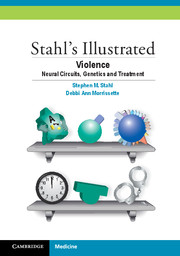Book contents
- Frontmatter
- Preface
- Contents
- CME Information
- Objectives
- Introduction
- Chapter 1 Which Individuals Will Become Violent or Aggressive?
- Chapter 2 Neurobiology and Genetics of Violence and Aggression
- Chapter 3 Treatment of Violence and Aggression
- Summary
- Suggested Reading
- Index
- CME: Posttest and Certificate
Summary
Published online by Cambridge University Press: 19 October 2021
- Frontmatter
- Preface
- Contents
- CME Information
- Objectives
- Introduction
- Chapter 1 Which Individuals Will Become Violent or Aggressive?
- Chapter 2 Neurobiology and Genetics of Violence and Aggression
- Chapter 3 Treatment of Violence and Aggression
- Summary
- Suggested Reading
- Index
- CME: Posttest and Certificate
Summary
• Violence can be impulsive, psychotic, or psychopathic.
• There is a high association of violence with genetic susceptibility plus an unfavorable environment.
• There are many routes to violence (e.g., mental illnesses and unfavorable factors such as substance abuse).
• Various areas of the prefrontal cortex and the amygdala are hypothetically linked to symptoms of psychotic, impulsive, and psychopathic violence.
• Understanding the topographical distribution of symptoms and their regulation by neurotransmitters provides a rationale for the psychopharmacological treatment of violence and aggression.
• There are several treatment options available for reducing the occurrence of violent or aggressive behavior; however, much of the evidence is practicebased because violent individuals are often excluded from clinical drug trials.
• Treatment with antipsychotics, especially at high doses, may be one of the most effective strategies for treating patients who are violent or aggressive.
• Although standard doses of all antipsychotics target 60-80% occupancy of D2 receptors, this may not be sufficient to quell violence and aggression in all patients.
• Pharmacokinetic treatment failure occurs when D2 receptors are inadequately occupied; such failure may be managed by high dosing, novel routes of administration, or the administration of some antipsychotics with food.
• Pharmacodynamic treatment failure occurs when patients do not respond despite achieving 80% D2 receptor occupancy; such failure can be managed by high dosing, very long treatment duration, or polypharmacy.
• Clozapine, polypharmacy, or high-dose antipsychotic monotherapy may be justified in some cases, especially if effective in reducing assaults and if side effects are carefully monitored.
• Additional strategies for managing violent or aggressive behavior include mood stabilizers, antidepressants, stimulants, adrenergic blockers, opiate antagonists, and benzodiazepines; however, evidence for the efficacy of these agents is limited and controversial.
• The addition of psychotherapy to pharmacological treatment may provide the most effective means for preventing violent or aggressive behavior.
- Type
- Chapter
- Information
- Stahl's Illustrated ViolenceNeural Circuits, Genetics and Treatment, pp. 81 - 82Publisher: Cambridge University PressPrint publication year: 2014



